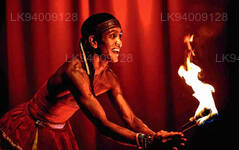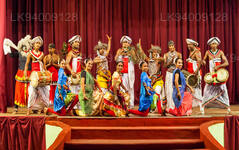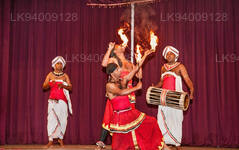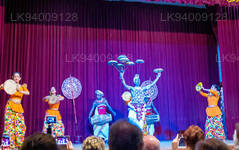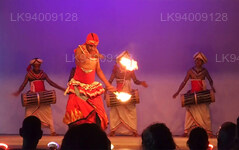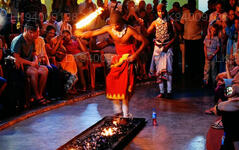
Kandy City
Kandy, en malerisk by i det centrale Sri Lanka, er kendt for sin rige kulturarv, livlige festivaler og smukke natur. Beliggende midt i frodige bakker, er den hjemsted for Tandtemplet, der er på UNESCOs verdensarvsliste, og byder på en betagende blanding af historie og naturlig pragt.
Kandy Cultural Show
The Kandy Lake Club Cultural Dance Show is a stimulating Sri Lankan Arts, Dance & Cultural Heritage Show that is a must see for any visitor who visits the historic city of Kandy. The Kandy Lake Club Dance started in 1982 with the view of having a cultural dance performance bringing together all Sri Lankan dance types to one platform. It is the first Cultural Dance Show of its kind to be established in Sri Lanka. It has since become a tourist attraction for many people visiting the country and keen on a glimpse of its rich cultural heritage. Hence it has been performing continuously for the last 35 years. Dance techniques unique to areas of the island are usually passed on from generation to generation. These Dances are performed at local ceremonies and rituals using drums and costumes that are unique to each area. Among the attractions are the Dances depicting the majestic walk of the elephant, colourful performance of the peacock and the mystical movements of the cobra. There are also dances with traditional masks, traditional drums and flames. The show ends with the unbelievable feat of walking on red-hot charcoal, which is a traditional form of worship of local gods. Right throughout the show you can enjoy the sounds of drums and other traditional musical instruments of Sri Lanka.  A hand out in different languages gives our customers a description of every item with all interesting facts and features of the dance show.
The Kandy Lake Club Cultural Dance Show is a stimulating Sri Lankan Arts, Dance & Cultural Heritage Show that is a must see for any visitor who visits the historic city of Kandy. The Kandy Lake Club Dance started in 1982 with the view of having a cultural dance performance bringing together all Sri Lankan dance types to one platform. It is the first Cultural Dance Show of its kind to be established in Sri Lanka. It has since become a tourist attraction for many people visiting the country and keen on a glimpse of its rich cultural heritage. Hence it has been performing continuously for the last 35 years.
- Magul Bera: The blowing of the Conch Shell is the traditional invocation at the commencement of any function and the drums are an integral part of the ritual. It is an ancient Sinhala custom to present ritual music when seeking the blessings of the Guardian of the land.
- Puja Natuma: The female dancers carrying oil lamps are making an offering of their dancing skills to the Guardian Deities.
- Devol Natuma: A dance sequence performed for general immunity from evil influences as well as for healing specific ailments. It is a part of a ceremony connected with folk believes. The vigorous movements of the dancers are derived from the dance forms of the Southern parts of Sri Lanka.
- Mayura Natuma:The female dancers depict the graceful movements of the peacock which according to mythology is the bird that transports Skanda, the War-God of Ceylon, worshipped by Buddhists and Hindus alike.
- Pantheru Natuma: The name of the dance is derived from the musical instrument used, the pantheru, which is close akin to the tambourine. Rhythm is also provided by the accompanying drums. The dance itself shows Sinhala warriors on their way to battle.
- Raksha Natuma: A South Sri Lanka mask dance with the raksha masks symbolising the fight between a cobra and a bird. This dance is used to exorcise demons from the possessed and is still believed to be effective psychiatric treatment in Sri Lanka.
- Lee Keli Natuma: A dance popular in the all parts of the country, particularly during festivals in which both male and female dancers participate. Each dancer has two sticks and the sound of the sticks striking each other together with those of the accompanying drums provide the rhythm for the dancers.
- Raban Natuma: A traditional folk dance which uses the Rabana, an instrument similar to the drum. The popular Ath Rabana (hand Rabana) is almost one foot in diameter and is both played and wielded in a variety of forms by the male and female dancers. Raban playing is accompanied by singing too.
- Gini Sisila: A south Ceylon fire dance showing the power of charms over fire and the twenty seven devils that can trouble mankind. The absolute faith of the fire dancers protects them from the flames. This dance also includes fire-eating.
- Ves Natuma: This dance is the one of the most important forms of Kandyan dance. Ves is the traditional attire of the Kandyan dancer. Sixty four ornaments complete the dress and traditionally their sheen symbolizes the rays of the sun. It takes years of rigorous training before a dancer can achieve the status of a fully-fledged ves dancer.
- Kulu Natuma: A traditional folk dance performed by village damsels to celebrate a rich harvest. The dance portrays sequences from reaping to winnowing of the grain. This is a buoyant dance providing ample opportunities for displaying feminine grace. It is performed to the accompaniment of light drum beats and the haunting strains of the flute.
- Fire walking: The origin of fire walking can be traced back to the epic story of Rama and Sita. Ravana, the King of Ceylon, had abducted the princess of India, Sita. When Rama her husband (an Indian King) regained her, she proved her chastity during her enforced stay with Ravana, by walking on fire, barefoot and unhurt. The devotees who perform fire-walking seek the divine blessings of Lord Kataragama and Goddess Pattini before they do so.
During the show, you will see several dances which depict the graceful movements of birds and animals, which trace their origins back to the ancient ritual known as the Kohomba Kapkariya, as well as energetic acrobatic performances where the men perform a series of leaping pirouettes and stunts such as plate-spinning and the dramatic ‘fire walk’ which ends the show.
Om Kandy-distriktet
Kandy-distriktet ligger i den centrale provins i Sri Lanka. Kandy er et af Sri Lankas syv verdensarvssteder og var engang hjemsted for Kandy-kongerne i det 16. århundrede og en kilde til al musik, kunst, håndværk og kultur i landet. Omkring 129 km fra Colombo ligger Kandy i et bakket terræn, og alles øjne drages mod byens centrum, hvor Kandy-søen danner et charmerende element. Kandy har fortsat stor religiøs betydning for Sri Lanka, fordi det er i denne charmerende by, at Dalada Maligawa eller "Tandtemplet" ligger, hvor Buddhas hellige tandrelikvie ligger velbevogtet.
Den Kongelige Botaniske Have i Peradeniya ligger omkring 5 km vest for bymidten i Peradeniya og besøges af 1,2 millioner mennesker om året. Det er den største botaniske have på øen. Udawatta Kele (Udawatta-skoven) er et beskyttet reservat beliggende i hjertet af byen, lige nord for Tandtemplet.
Kandy er en by med et flertal af singalesere; der er betydelige samfund, der tilhører andre etniske grupper, såsom maurere og tamiler. Kandy er kun overgået af Colombo, centrum for Sri Lankas økonomi. Mange store kooperativer har store filialer i Kandy, og mange industrier, herunder tekstiler, møbler, informationsteknologi og smykker, findes her. Mange landbrugsforskningscentre er placeret i byen.
Og et springvand for al musik, kunst, kunsthåndværk og kultur i landet. Omkring 129 km fra Colombo ligger Kandy i et bakket terræn, og alles øjne drages mod byens centrum, hvor Kandy-søen danner et charmerende træk. Kandy har fortsat stor religiøs betydning for Sri Lanka, fordi det er i denne charmerende by, at Dalada Maligawa eller Tandtemplet ligger, hvor Buddhas hellige tandrelikvie ligger velbevaret.
Om Centralprovinsen
Den centrale provins i Sri Lanka består primært af bjergrigt terræn. Provinsen har et areal på 5.674 km² og en befolkning på 2.421.148. Nogle større byer inkluderer Kandy, Gampola (24.730), Nuwara Eliya og Bandarawela. Befolkningen er en blanding af singalesere, tamiler og maurere.
Både bjerghovedstaden Kandy og byen Nuwara Eliya ligger i Centralprovinsen, såvel som Sri Pada. Provinsen producerer en stor del af den berømte Ceylon-te, som blev plantet af briterne i 1860'erne, efter at en ødelæggende sygdom havde dræbt alle kaffeplantagerne i provinsen. Centralprovinsen tiltrækker mange turister med bjergbyer som Kandy, Gampola, Hatton og Nuwara Eliya. Tempeltand eller Dalada maligawa er det vigtigste hellige sted i Centrel-provinsen.
Klimaet er køligt, og mange områder omkring 1500 meter har ofte kølige nætter. De vestlige skråninger er meget våde, nogle steder med næsten 7000 mm regn om året. De østlige skråninger er dele af den midterste tørre zone, da den kun modtager regn fra den nordøstlige monsun. Temperaturerne varierer fra 24°C i Kandy til kun 16°C i Nuwara Eliya, som ligger 1.889 m over havets overflade. De højeste bjerge i Sri Lanka ligger i Centralprovinsen. Terrænet er for det meste bjergrigt med dybe dale, der skærer sig ind i det. De to vigtigste bjergregioner er det centrale massiv og Knuckles-bjergkæden øst for Kandy.

